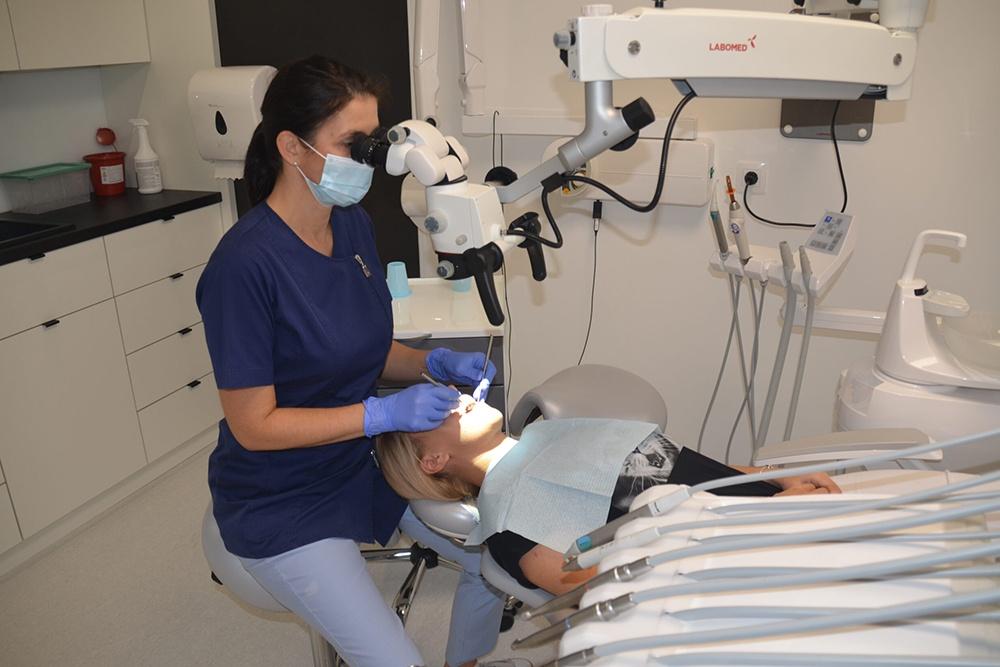
21 Dec Root canal treatment (endodontic)
Root canal treatment is a common dental procedure used to preserve a tooth after irreversible inflammation of the tooth pulp. This is usually caused by a deep cavity or physical trauma to the face or teeth.
The dental pulp is the soft tissue inside the tooth containing connective tissue, nerves and blood vessels.
During root canal treatment, the dentist-endodontist removes infected tissue from the pulp chamber and canals, works them out, and then disinfects and seals the canals and tooth.
Root canal treatment is necessary when the pulp becomes inflamed through continuous irritation, gradually leading to necrosis. The causative factors are usually deep carious cavities. Pulp necrosis may also occur in other circumstances, e.g. when the crown of the tooth is broken off, when the tooth is dislocated, when there is significant tooth wear or when periodontitis is present. Endodontic treatment is also often necessary prior to planned prosthetic treatment.
Symptoms that indicate that root canal treatment is necessary:
- Toothache: Pulpitis is accompanied by intractable pain. The pain may worsen when eating. Most often, however, it is a spontaneous pain that awakens from sleep. The discomfort is so severe that it radiates to the ear, temples and it is difficult to pinpoint the causative tooth because it hurts half the head.
- Fistula (purulent pustule on the gum): A fistula is a small white, yellow or red pimple-like lump that appears on the gum. This situation indicates to the dentist that an infection has occurred. The problem is that a fistula can confuse the dentist as to which tooth needs root canal treatment and, importantly, it does not always appear next to an infected tooth.
- Swollen gums: as the infected tooth tries to 'remove' the toxic effects of the infection, it can also cause swelling, redness and sensitivity of the gums. Purulent exudate may accumulate in the soft tissues.
- Change in the colour of the tooth or gums: A dead or dying tooth can turn grey over time as its blood supply decreases. The infection can also darken the part of the gum around the tooth.
- Tooth loosening: as the infection spreads, it can soften or degrade the bone in which the tooth is located. This can cause such a tooth to become mobile, moving on contact.
- Deep cavity: can cause many of the above symptoms, such as pain. Your dentist can use X-rays or cone beam computed tomography (CBCT) to diagnose the extent of decay.
Is root canal treatment needed if the tooth does not hurt?
Yes, if the dentist finds periapical tissue inflammation on the basis of an X-ray, such a tooth is qualified for root canal treatment. Regardless of whether there is pain or not. The root canal treatment can be performed in one or two visits. In the case of repeat treatments (where the tooth has already been endodontically treated), a third visit may also be necessary.
The visit associated with root canal treatment lasts approximately 30-90 minutes. In cases of teeth with more canals (molars), the visit will be longer than for treatment of incisors.
This is what a step-by-step root canal treatment looks like:
- X-rays and examination: Before the root canal treatment, the dentist will take an X-ray or cone beam CT scan to make an accurate diagnosis and plan the treatment.
- Anaesthesia: the patient is given a local anaesthetic to make the procedure completely painless.
- Cofferdam: A sheet of latex, called a cofferdam, will be applied to the tooth. This prevents bacteria from the rest of the mouth entering the tooth. Cofferdam also prevents the swallowing of fluids used during root canal preparation.
- Development of the cavity: decay will be removed from the tooth.
- Cleaning and shaping: Using very sophisticated drills and files, the dentist will remove the infected pulp, carefully cleaning and shaping the inside of the tooth. Using a special device - an endometer - the length of the canals is determined. The use of a treatment microscope makes it much easier to see into the tooth cavity and even into the lumen of the canals, thus improving the quality of treatment.
- Irrigation: During root canal preparation, disinfectant fluids are used to eliminate any remaining bacteria. The canals must be completely dry before proceeding to the next step.
- Filling: The dentist will then fill the root canal system and rebuild the tooth tightly. The canals are filled with gutta-percha, while the tooth cavity can be restored with a composite filling or prosthetic work (onlay or prosthetic crown). Once the treatment is complete, the dentist takes an X-ray to check the filling of the canals.
After root canal treatment, pain is sometimes experienced due to irritation of the tissues surrounding the tooth. If these are very bothersome, an analgesic should be taken. Usually, the pain disappears spontaneously within a few days after the treatment.
Root canal treatment under the microscope is a modern high-precision treatment method. The use of the microscope allows extremely precise preparation of the tooth canals thanks to multiple magnification and uniformity of the treatment area. All this translates into a high degree of effectiveness of microscopic root canal treatment, making it possible to avoid extraction of the diseased tooth.

